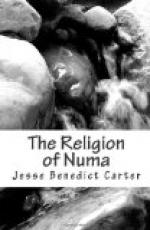We see from this on what a small resemblance such identifications were based, in this case merely on the presence of a similar minor injunction in the laws of each cult. But we have here at least a genuine cult which had arrived and was asking for admission, and in so far we are better off than in most instances, where nothing substantial was gained by the identification. Two forces were now at work assisting in this fusion of Greek and Roman gods, namely art and literature. The capture of Syracuse marked an epoch in Rome’s artistic career; for several centuries she had employed Greek architects and had also become acquainted with the artistic types of certain Greek gods, but now all at once a wealth of Greek sculpture was disclosed to her, and she could not rest content until all her gods were represented in the fashion of man. The adoption of the Greek type, in those cases where an identification had already been effected, was not difficult and was in the main successful, though there followed almost inevitably an enrichment of the Greek element in the Roman god because of the presence of some attribute in the statue, which brought its own myth with it. But there were certain Roman gods for whom Greek parallels could not be found, and in these cases a compromise, usually rather an awkward one, had to be effected, as for example when the Roman gods of the storeroom, the Di Penates, were represented by statues of the Greek Castor and Pollux. In such cases confusion was sure to follow, and subsequent antiquarians would be tempted to write treatises proving the original connexion of Castor or Pollux with the Penates, as gods of protection in general, etc. Literature too in its own way was fully as misleading, and Roman scholars became fascinated with the labyrinths of Alexandrian mythology, and straightway began to build Roman myths as rapidly as possible, establishing lists of old Latin kings and all sorts of genealogies, and weaving as many Greek mythological figures as possible into the legends of the foundation of Italic towns.




